Analyzing the Macroeconomic Influence on Human Resource Management
VerifiedAdded on 2020/03/16
|8
|1606
|49
Report
AI Summary
This report examines the multifaceted influence of macroeconomic factors on Human Resource Management (HRM). It explores how economic conditions, including labor market dynamics, GDP growth, and technological advancements, shape HRM practices. The report further analyzes the impact of social factors such as changing demographics and the demand for work-life balance, as well as the influence of political contexts like government policies, international labor laws, and bilateral relationships between nations. Additionally, it considers the global context, encompassing political, economic, social, and technological factors that affect HRM in multinational companies. The study highlights how these macroeconomic elements necessitate strategic adjustments in HRM operations, including talent acquisition, employee management, and policy formulation, to align with broader economic, social, and political landscapes. The report utilizes research from Cooke, Saini and Wang (2014), Peppard and Ward (2016), and others to support its analysis.
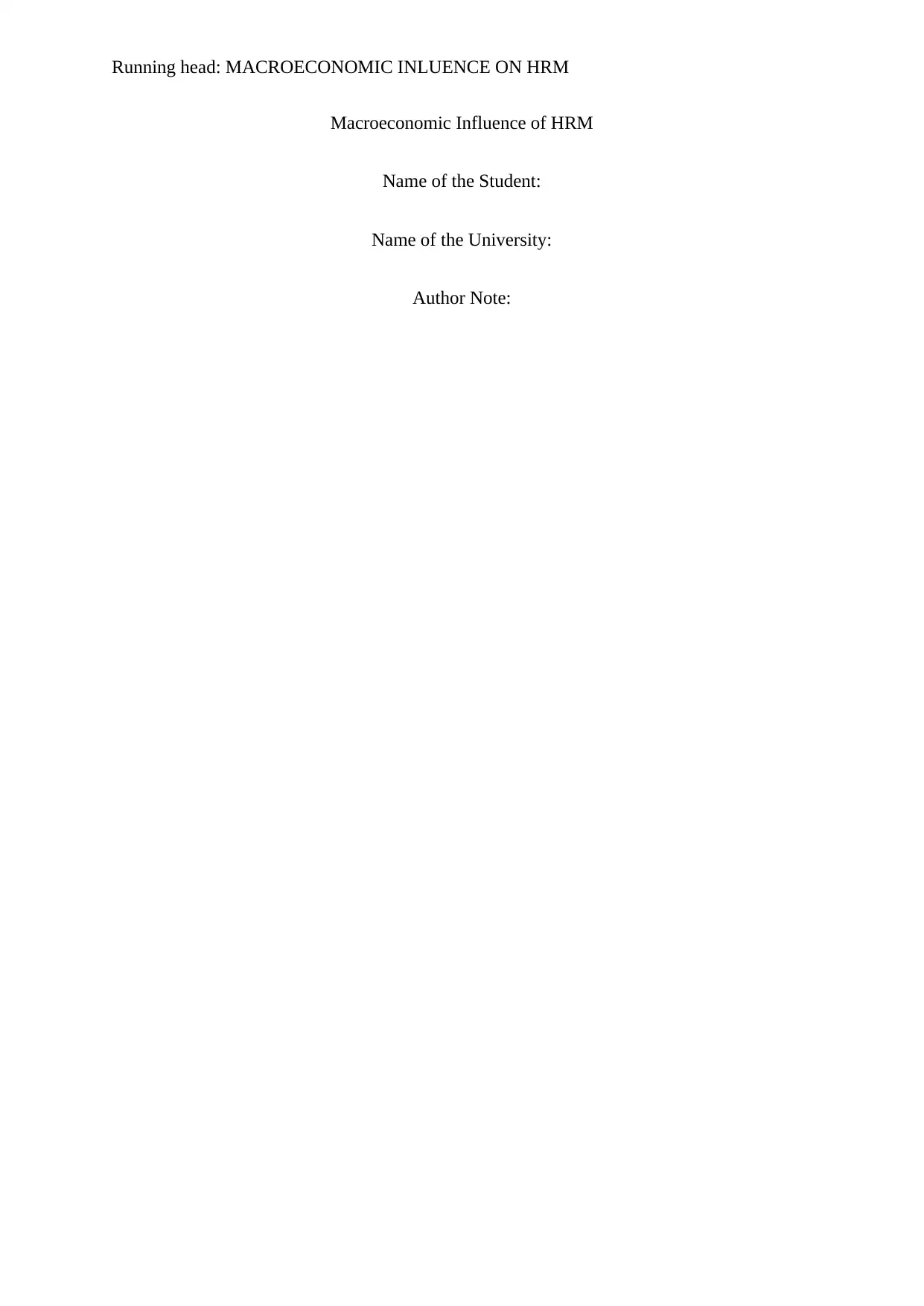
Running head: MACROECONOMIC INLUENCE ON HRM
Macroeconomic Influence of HRM
Name of the Student:
Name of the University:
Author Note:
Macroeconomic Influence of HRM
Name of the Student:
Name of the University:
Author Note:
Paraphrase This Document
Need a fresh take? Get an instant paraphrase of this document with our AI Paraphraser
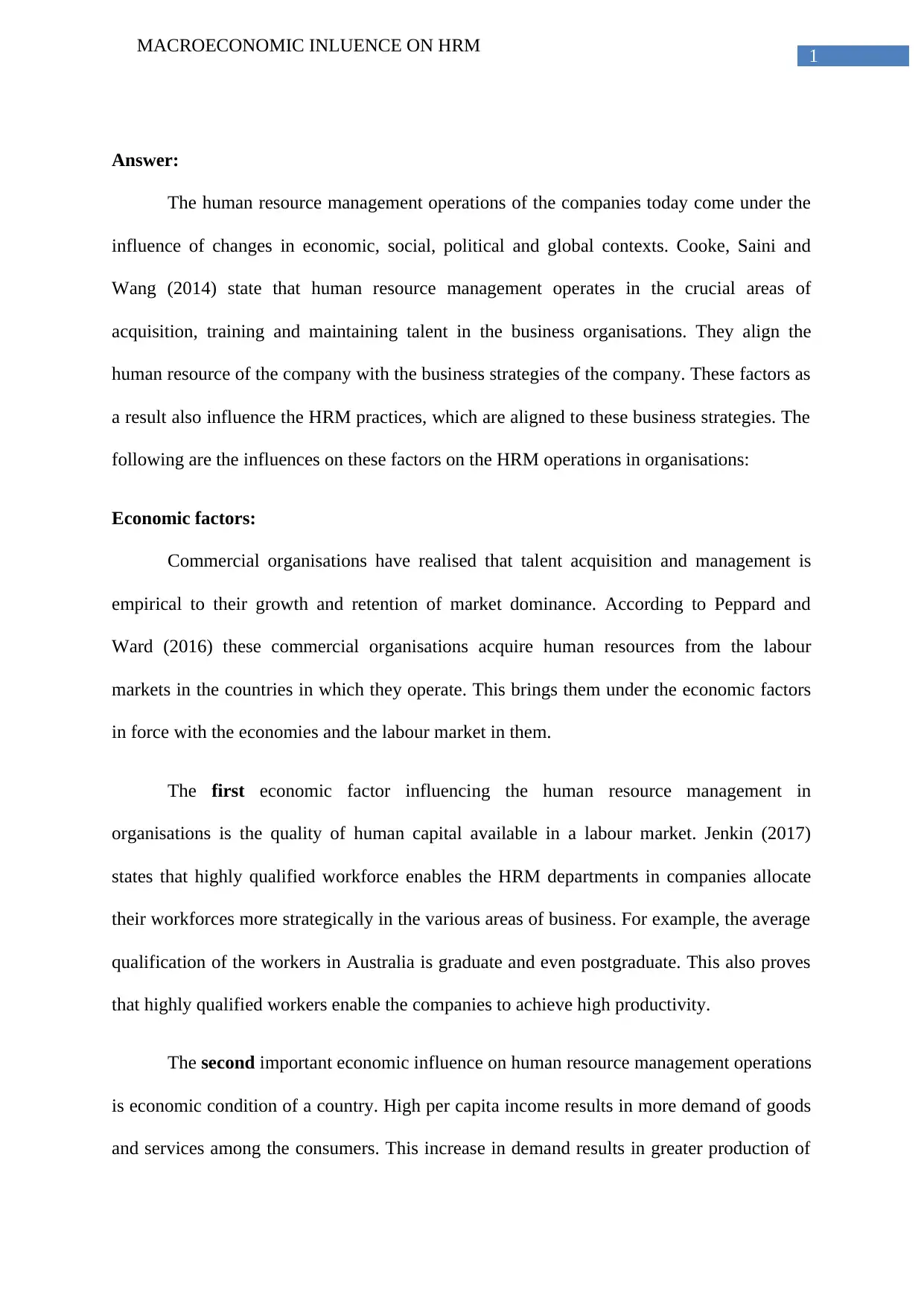
1
MACROECONOMIC INLUENCE ON HRM
Answer:
The human resource management operations of the companies today come under the
influence of changes in economic, social, political and global contexts. Cooke, Saini and
Wang (2014) state that human resource management operates in the crucial areas of
acquisition, training and maintaining talent in the business organisations. They align the
human resource of the company with the business strategies of the company. These factors as
a result also influence the HRM practices, which are aligned to these business strategies. The
following are the influences on these factors on the HRM operations in organisations:
Economic factors:
Commercial organisations have realised that talent acquisition and management is
empirical to their growth and retention of market dominance. According to Peppard and
Ward (2016) these commercial organisations acquire human resources from the labour
markets in the countries in which they operate. This brings them under the economic factors
in force with the economies and the labour market in them.
The first economic factor influencing the human resource management in
organisations is the quality of human capital available in a labour market. Jenkin (2017)
states that highly qualified workforce enables the HRM departments in companies allocate
their workforces more strategically in the various areas of business. For example, the average
qualification of the workers in Australia is graduate and even postgraduate. This also proves
that highly qualified workers enable the companies to achieve high productivity.
The second important economic influence on human resource management operations
is economic condition of a country. High per capita income results in more demand of goods
and services among the consumers. This increase in demand results in greater production of
MACROECONOMIC INLUENCE ON HRM
Answer:
The human resource management operations of the companies today come under the
influence of changes in economic, social, political and global contexts. Cooke, Saini and
Wang (2014) state that human resource management operates in the crucial areas of
acquisition, training and maintaining talent in the business organisations. They align the
human resource of the company with the business strategies of the company. These factors as
a result also influence the HRM practices, which are aligned to these business strategies. The
following are the influences on these factors on the HRM operations in organisations:
Economic factors:
Commercial organisations have realised that talent acquisition and management is
empirical to their growth and retention of market dominance. According to Peppard and
Ward (2016) these commercial organisations acquire human resources from the labour
markets in the countries in which they operate. This brings them under the economic factors
in force with the economies and the labour market in them.
The first economic factor influencing the human resource management in
organisations is the quality of human capital available in a labour market. Jenkin (2017)
states that highly qualified workforce enables the HRM departments in companies allocate
their workforces more strategically in the various areas of business. For example, the average
qualification of the workers in Australia is graduate and even postgraduate. This also proves
that highly qualified workers enable the companies to achieve high productivity.
The second important economic influence on human resource management operations
is economic condition of a country. High per capita income results in more demand of goods
and services among the consumers. This increase in demand results in greater production of
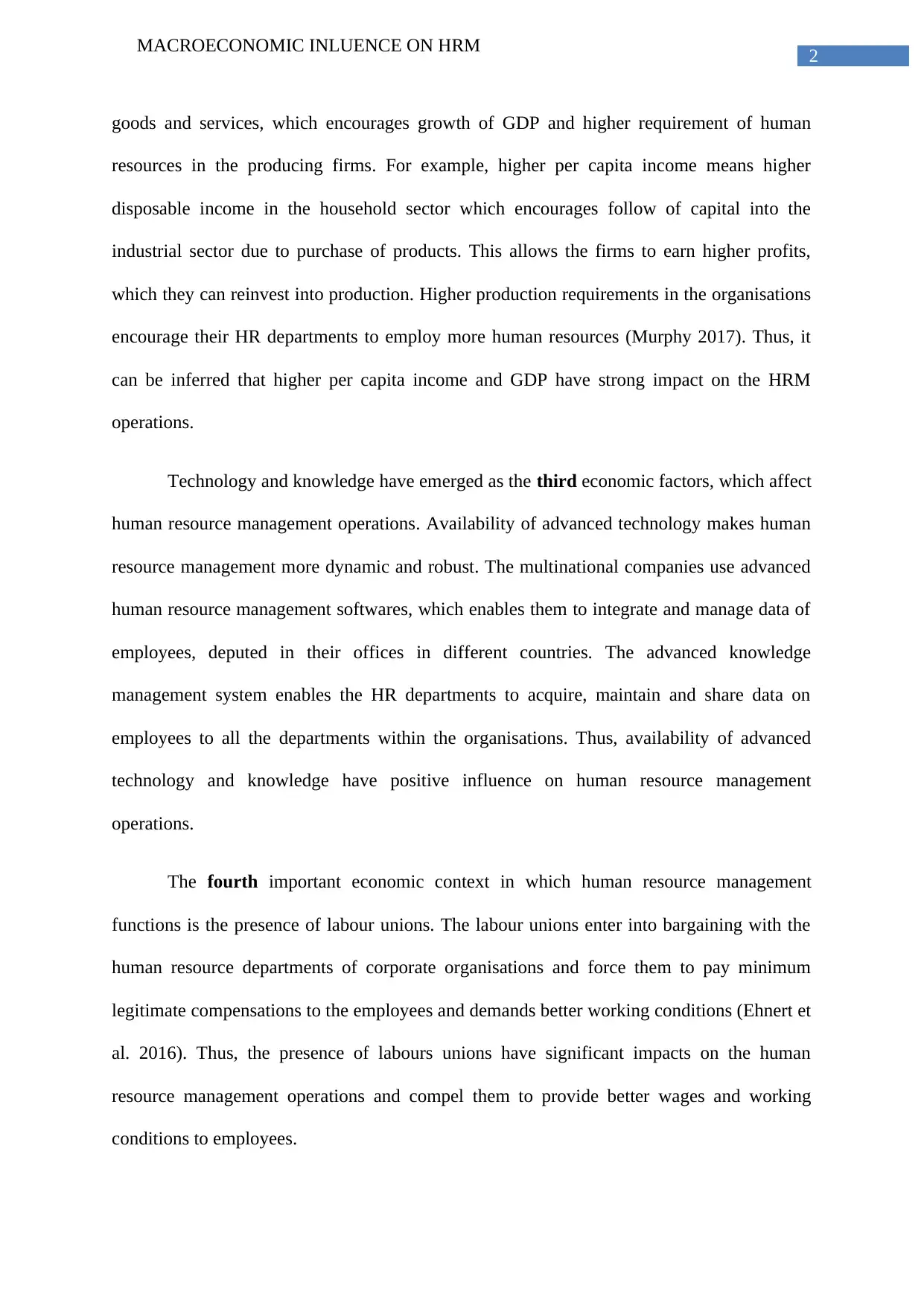
2
MACROECONOMIC INLUENCE ON HRM
goods and services, which encourages growth of GDP and higher requirement of human
resources in the producing firms. For example, higher per capita income means higher
disposable income in the household sector which encourages follow of capital into the
industrial sector due to purchase of products. This allows the firms to earn higher profits,
which they can reinvest into production. Higher production requirements in the organisations
encourage their HR departments to employ more human resources (Murphy 2017). Thus, it
can be inferred that higher per capita income and GDP have strong impact on the HRM
operations.
Technology and knowledge have emerged as the third economic factors, which affect
human resource management operations. Availability of advanced technology makes human
resource management more dynamic and robust. The multinational companies use advanced
human resource management softwares, which enables them to integrate and manage data of
employees, deputed in their offices in different countries. The advanced knowledge
management system enables the HR departments to acquire, maintain and share data on
employees to all the departments within the organisations. Thus, availability of advanced
technology and knowledge have positive influence on human resource management
operations.
The fourth important economic context in which human resource management
functions is the presence of labour unions. The labour unions enter into bargaining with the
human resource departments of corporate organisations and force them to pay minimum
legitimate compensations to the employees and demands better working conditions (Ehnert et
al. 2016). Thus, the presence of labours unions have significant impacts on the human
resource management operations and compel them to provide better wages and working
conditions to employees.
MACROECONOMIC INLUENCE ON HRM
goods and services, which encourages growth of GDP and higher requirement of human
resources in the producing firms. For example, higher per capita income means higher
disposable income in the household sector which encourages follow of capital into the
industrial sector due to purchase of products. This allows the firms to earn higher profits,
which they can reinvest into production. Higher production requirements in the organisations
encourage their HR departments to employ more human resources (Murphy 2017). Thus, it
can be inferred that higher per capita income and GDP have strong impact on the HRM
operations.
Technology and knowledge have emerged as the third economic factors, which affect
human resource management operations. Availability of advanced technology makes human
resource management more dynamic and robust. The multinational companies use advanced
human resource management softwares, which enables them to integrate and manage data of
employees, deputed in their offices in different countries. The advanced knowledge
management system enables the HR departments to acquire, maintain and share data on
employees to all the departments within the organisations. Thus, availability of advanced
technology and knowledge have positive influence on human resource management
operations.
The fourth important economic context in which human resource management
functions is the presence of labour unions. The labour unions enter into bargaining with the
human resource departments of corporate organisations and force them to pay minimum
legitimate compensations to the employees and demands better working conditions (Ehnert et
al. 2016). Thus, the presence of labours unions have significant impacts on the human
resource management operations and compel them to provide better wages and working
conditions to employees.
⊘ This is a preview!⊘
Do you want full access?
Subscribe today to unlock all pages.

Trusted by 1+ million students worldwide
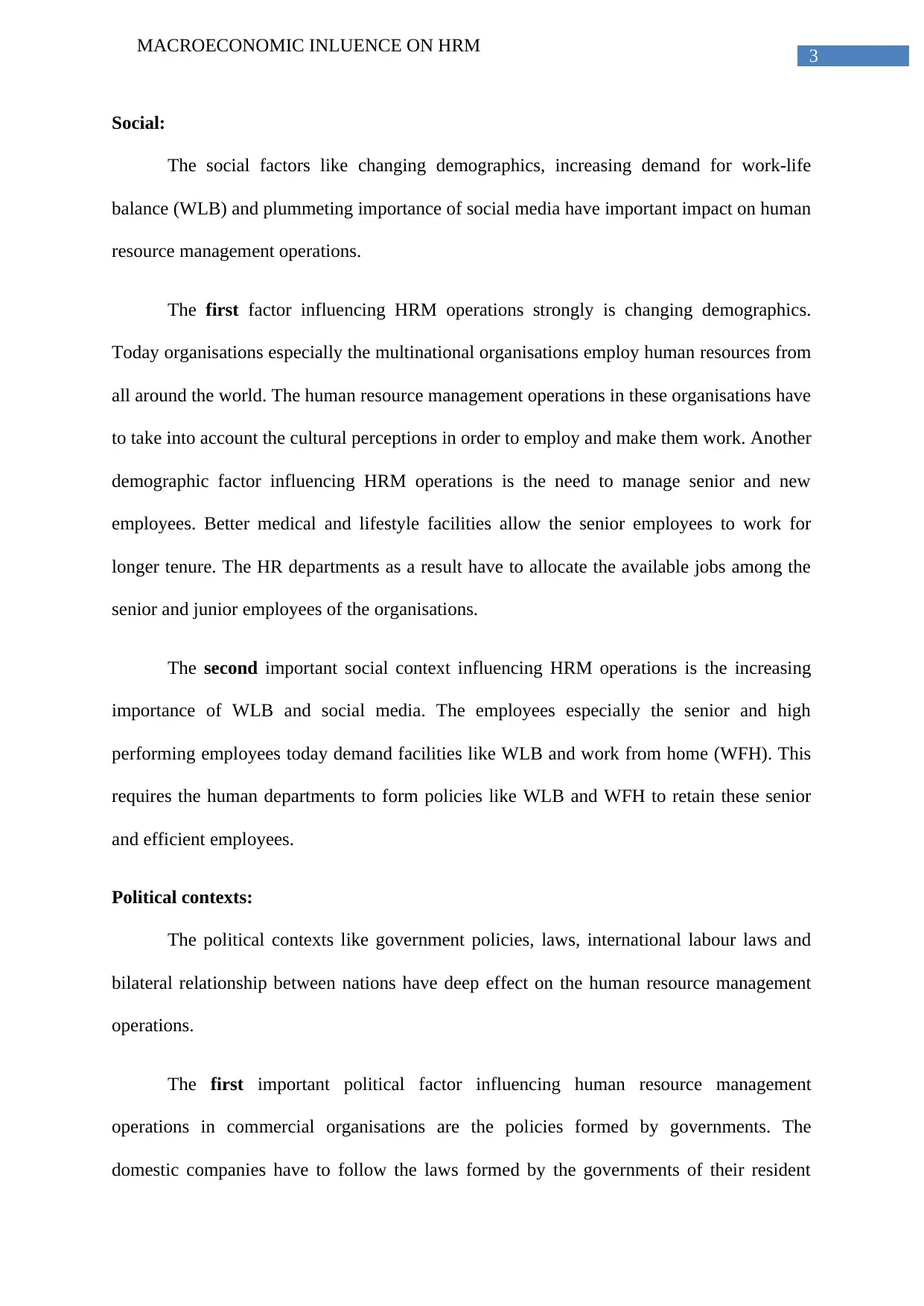
3
MACROECONOMIC INLUENCE ON HRM
Social:
The social factors like changing demographics, increasing demand for work-life
balance (WLB) and plummeting importance of social media have important impact on human
resource management operations.
The first factor influencing HRM operations strongly is changing demographics.
Today organisations especially the multinational organisations employ human resources from
all around the world. The human resource management operations in these organisations have
to take into account the cultural perceptions in order to employ and make them work. Another
demographic factor influencing HRM operations is the need to manage senior and new
employees. Better medical and lifestyle facilities allow the senior employees to work for
longer tenure. The HR departments as a result have to allocate the available jobs among the
senior and junior employees of the organisations.
The second important social context influencing HRM operations is the increasing
importance of WLB and social media. The employees especially the senior and high
performing employees today demand facilities like WLB and work from home (WFH). This
requires the human departments to form policies like WLB and WFH to retain these senior
and efficient employees.
Political contexts:
The political contexts like government policies, laws, international labour laws and
bilateral relationship between nations have deep effect on the human resource management
operations.
The first important political factor influencing human resource management
operations in commercial organisations are the policies formed by governments. The
domestic companies have to follow the laws formed by the governments of their resident
MACROECONOMIC INLUENCE ON HRM
Social:
The social factors like changing demographics, increasing demand for work-life
balance (WLB) and plummeting importance of social media have important impact on human
resource management operations.
The first factor influencing HRM operations strongly is changing demographics.
Today organisations especially the multinational organisations employ human resources from
all around the world. The human resource management operations in these organisations have
to take into account the cultural perceptions in order to employ and make them work. Another
demographic factor influencing HRM operations is the need to manage senior and new
employees. Better medical and lifestyle facilities allow the senior employees to work for
longer tenure. The HR departments as a result have to allocate the available jobs among the
senior and junior employees of the organisations.
The second important social context influencing HRM operations is the increasing
importance of WLB and social media. The employees especially the senior and high
performing employees today demand facilities like WLB and work from home (WFH). This
requires the human departments to form policies like WLB and WFH to retain these senior
and efficient employees.
Political contexts:
The political contexts like government policies, laws, international labour laws and
bilateral relationship between nations have deep effect on the human resource management
operations.
The first important political factor influencing human resource management
operations in commercial organisations are the policies formed by governments. The
domestic companies have to follow the laws formed by the governments of their resident
Paraphrase This Document
Need a fresh take? Get an instant paraphrase of this document with our AI Paraphraser
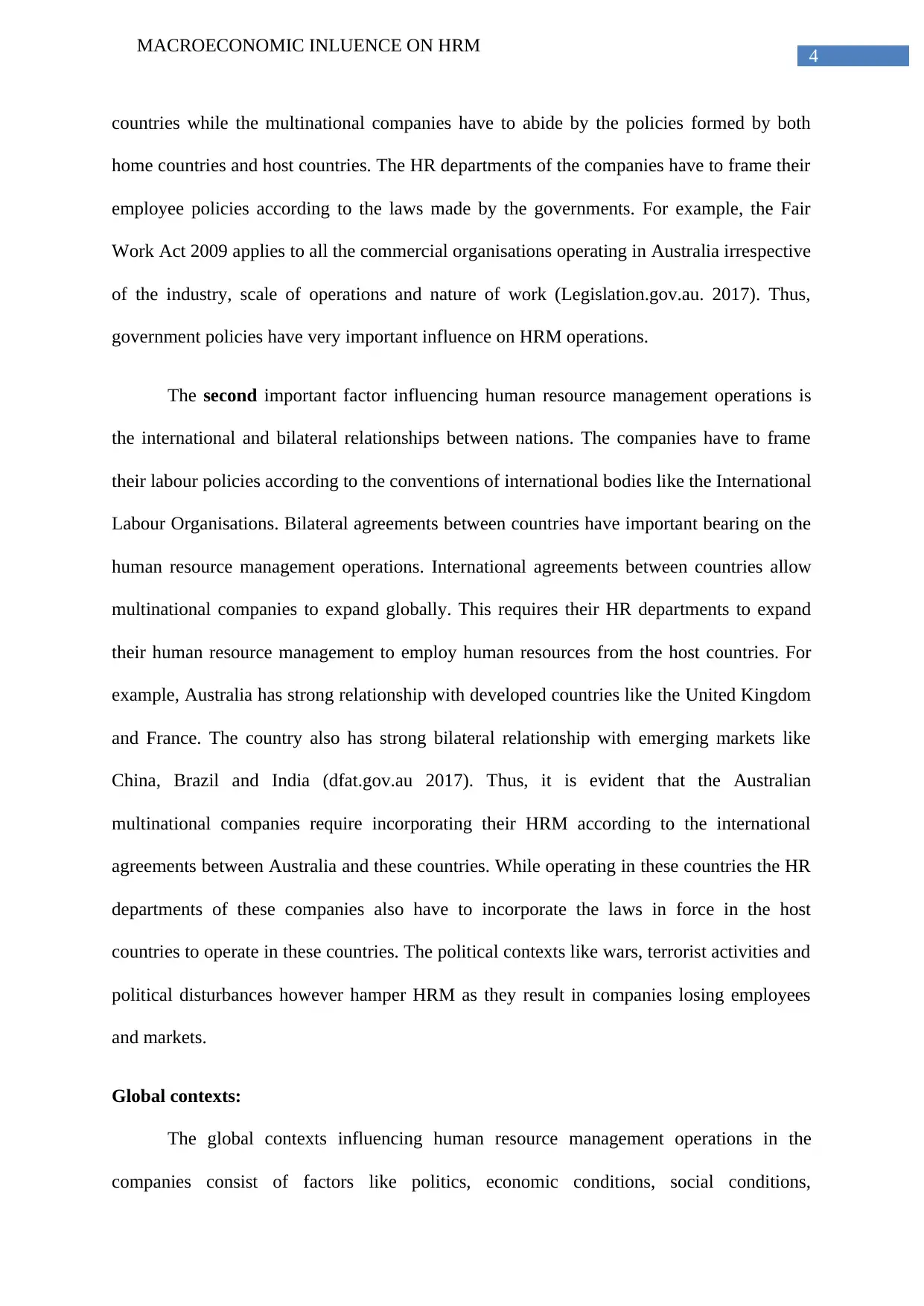
4
MACROECONOMIC INLUENCE ON HRM
countries while the multinational companies have to abide by the policies formed by both
home countries and host countries. The HR departments of the companies have to frame their
employee policies according to the laws made by the governments. For example, the Fair
Work Act 2009 applies to all the commercial organisations operating in Australia irrespective
of the industry, scale of operations and nature of work (Legislation.gov.au. 2017). Thus,
government policies have very important influence on HRM operations.
The second important factor influencing human resource management operations is
the international and bilateral relationships between nations. The companies have to frame
their labour policies according to the conventions of international bodies like the International
Labour Organisations. Bilateral agreements between countries have important bearing on the
human resource management operations. International agreements between countries allow
multinational companies to expand globally. This requires their HR departments to expand
their human resource management to employ human resources from the host countries. For
example, Australia has strong relationship with developed countries like the United Kingdom
and France. The country also has strong bilateral relationship with emerging markets like
China, Brazil and India (dfat.gov.au 2017). Thus, it is evident that the Australian
multinational companies require incorporating their HRM according to the international
agreements between Australia and these countries. While operating in these countries the HR
departments of these companies also have to incorporate the laws in force in the host
countries to operate in these countries. The political contexts like wars, terrorist activities and
political disturbances however hamper HRM as they result in companies losing employees
and markets.
Global contexts:
The global contexts influencing human resource management operations in the
companies consist of factors like politics, economic conditions, social conditions,
MACROECONOMIC INLUENCE ON HRM
countries while the multinational companies have to abide by the policies formed by both
home countries and host countries. The HR departments of the companies have to frame their
employee policies according to the laws made by the governments. For example, the Fair
Work Act 2009 applies to all the commercial organisations operating in Australia irrespective
of the industry, scale of operations and nature of work (Legislation.gov.au. 2017). Thus,
government policies have very important influence on HRM operations.
The second important factor influencing human resource management operations is
the international and bilateral relationships between nations. The companies have to frame
their labour policies according to the conventions of international bodies like the International
Labour Organisations. Bilateral agreements between countries have important bearing on the
human resource management operations. International agreements between countries allow
multinational companies to expand globally. This requires their HR departments to expand
their human resource management to employ human resources from the host countries. For
example, Australia has strong relationship with developed countries like the United Kingdom
and France. The country also has strong bilateral relationship with emerging markets like
China, Brazil and India (dfat.gov.au 2017). Thus, it is evident that the Australian
multinational companies require incorporating their HRM according to the international
agreements between Australia and these countries. While operating in these countries the HR
departments of these companies also have to incorporate the laws in force in the host
countries to operate in these countries. The political contexts like wars, terrorist activities and
political disturbances however hamper HRM as they result in companies losing employees
and markets.
Global contexts:
The global contexts influencing human resource management operations in the
companies consist of factors like politics, economic conditions, social conditions,
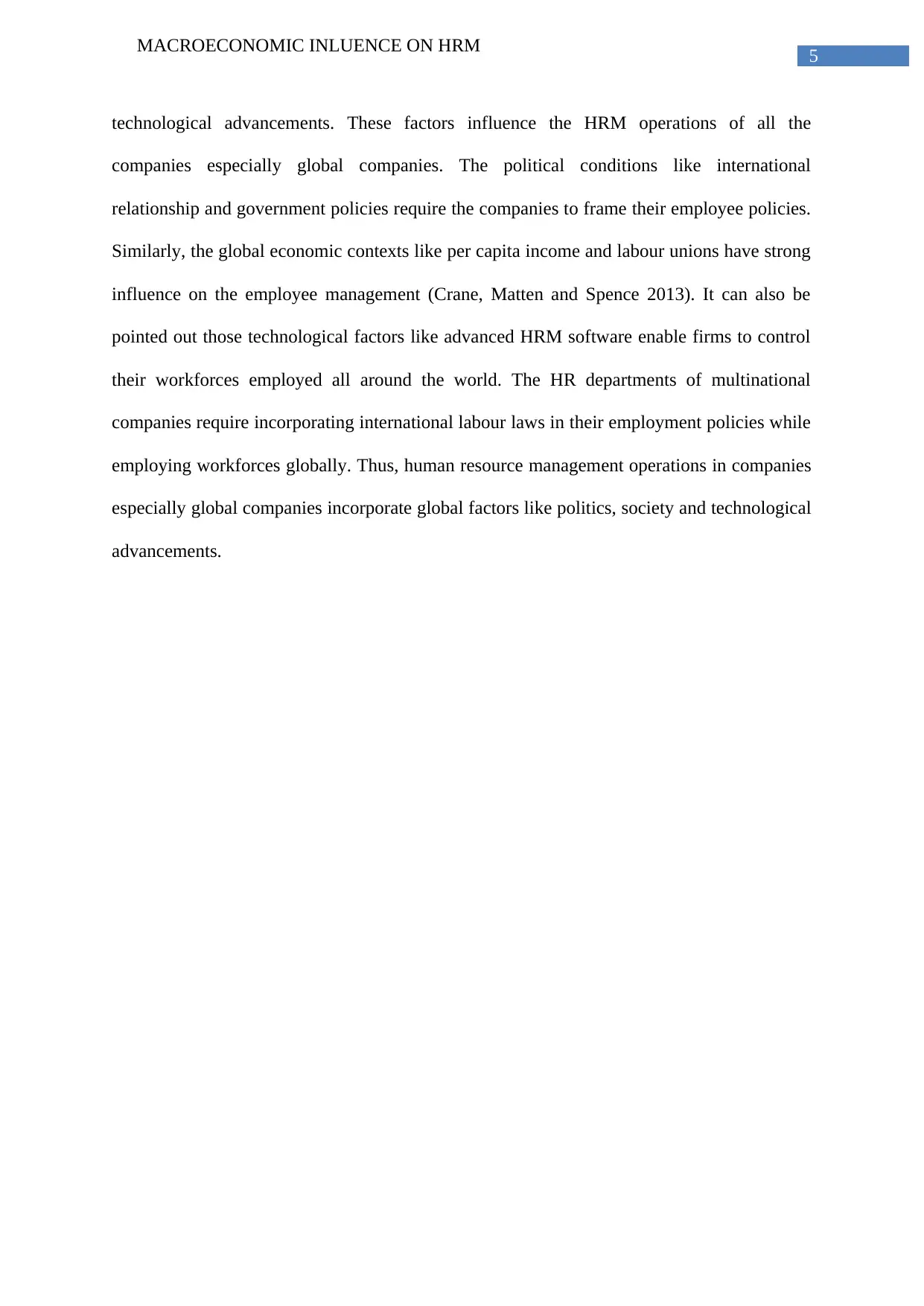
5
MACROECONOMIC INLUENCE ON HRM
technological advancements. These factors influence the HRM operations of all the
companies especially global companies. The political conditions like international
relationship and government policies require the companies to frame their employee policies.
Similarly, the global economic contexts like per capita income and labour unions have strong
influence on the employee management (Crane, Matten and Spence 2013). It can also be
pointed out those technological factors like advanced HRM software enable firms to control
their workforces employed all around the world. The HR departments of multinational
companies require incorporating international labour laws in their employment policies while
employing workforces globally. Thus, human resource management operations in companies
especially global companies incorporate global factors like politics, society and technological
advancements.
MACROECONOMIC INLUENCE ON HRM
technological advancements. These factors influence the HRM operations of all the
companies especially global companies. The political conditions like international
relationship and government policies require the companies to frame their employee policies.
Similarly, the global economic contexts like per capita income and labour unions have strong
influence on the employee management (Crane, Matten and Spence 2013). It can also be
pointed out those technological factors like advanced HRM software enable firms to control
their workforces employed all around the world. The HR departments of multinational
companies require incorporating international labour laws in their employment policies while
employing workforces globally. Thus, human resource management operations in companies
especially global companies incorporate global factors like politics, society and technological
advancements.
⊘ This is a preview!⊘
Do you want full access?
Subscribe today to unlock all pages.

Trusted by 1+ million students worldwide
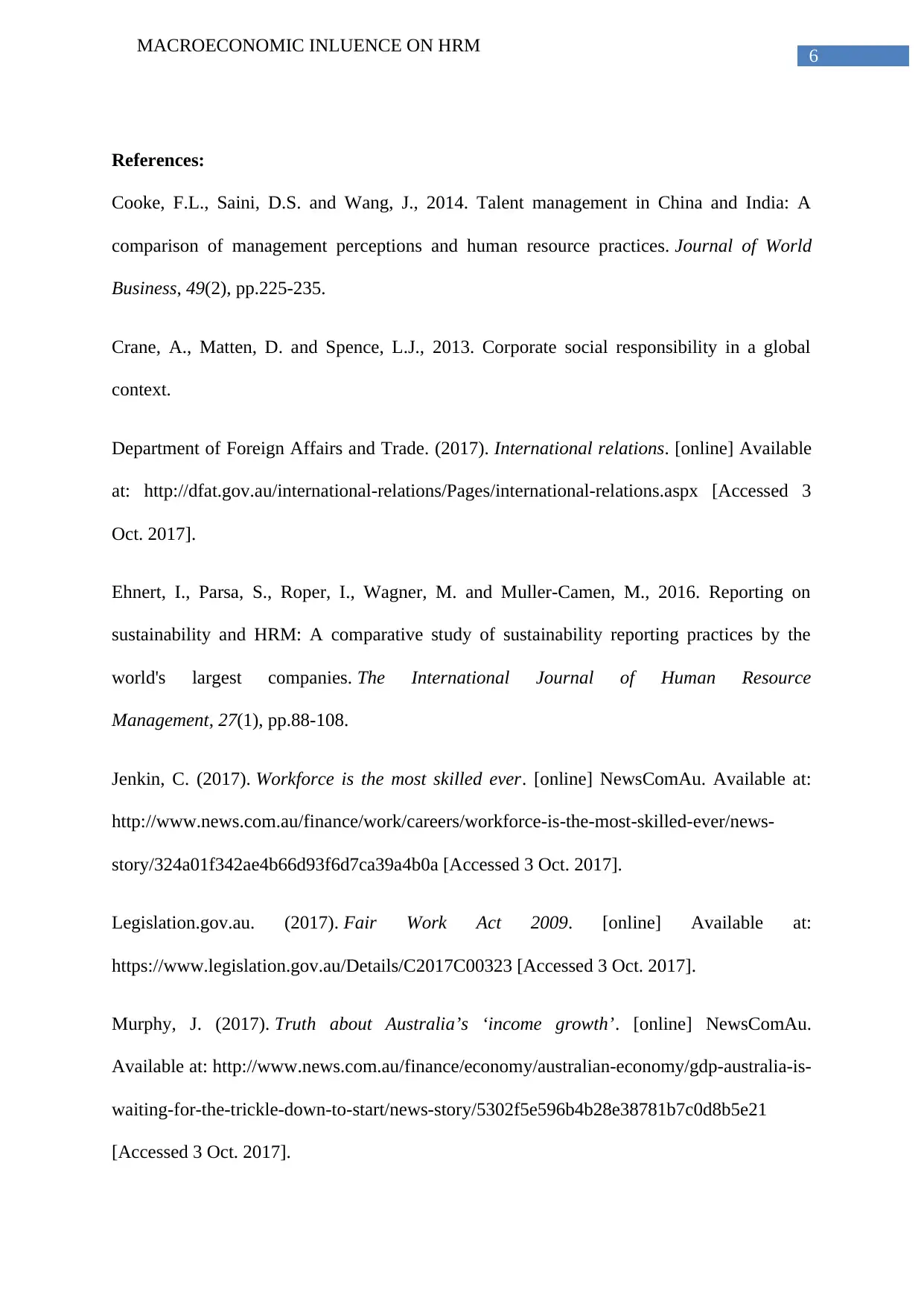
6
MACROECONOMIC INLUENCE ON HRM
References:
Cooke, F.L., Saini, D.S. and Wang, J., 2014. Talent management in China and India: A
comparison of management perceptions and human resource practices. Journal of World
Business, 49(2), pp.225-235.
Crane, A., Matten, D. and Spence, L.J., 2013. Corporate social responsibility in a global
context.
Department of Foreign Affairs and Trade. (2017). International relations. [online] Available
at: http://dfat.gov.au/international-relations/Pages/international-relations.aspx [Accessed 3
Oct. 2017].
Ehnert, I., Parsa, S., Roper, I., Wagner, M. and Muller-Camen, M., 2016. Reporting on
sustainability and HRM: A comparative study of sustainability reporting practices by the
world's largest companies. The International Journal of Human Resource
Management, 27(1), pp.88-108.
Jenkin, C. (2017). Workforce is the most skilled ever. [online] NewsComAu. Available at:
http://www.news.com.au/finance/work/careers/workforce-is-the-most-skilled-ever/news-
story/324a01f342ae4b66d93f6d7ca39a4b0a [Accessed 3 Oct. 2017].
Legislation.gov.au. (2017). Fair Work Act 2009. [online] Available at:
https://www.legislation.gov.au/Details/C2017C00323 [Accessed 3 Oct. 2017].
Murphy, J. (2017). Truth about Australia’s ‘income growth’. [online] NewsComAu.
Available at: http://www.news.com.au/finance/economy/australian-economy/gdp-australia-is-
waiting-for-the-trickle-down-to-start/news-story/5302f5e596b4b28e38781b7c0d8b5e21
[Accessed 3 Oct. 2017].
MACROECONOMIC INLUENCE ON HRM
References:
Cooke, F.L., Saini, D.S. and Wang, J., 2014. Talent management in China and India: A
comparison of management perceptions and human resource practices. Journal of World
Business, 49(2), pp.225-235.
Crane, A., Matten, D. and Spence, L.J., 2013. Corporate social responsibility in a global
context.
Department of Foreign Affairs and Trade. (2017). International relations. [online] Available
at: http://dfat.gov.au/international-relations/Pages/international-relations.aspx [Accessed 3
Oct. 2017].
Ehnert, I., Parsa, S., Roper, I., Wagner, M. and Muller-Camen, M., 2016. Reporting on
sustainability and HRM: A comparative study of sustainability reporting practices by the
world's largest companies. The International Journal of Human Resource
Management, 27(1), pp.88-108.
Jenkin, C. (2017). Workforce is the most skilled ever. [online] NewsComAu. Available at:
http://www.news.com.au/finance/work/careers/workforce-is-the-most-skilled-ever/news-
story/324a01f342ae4b66d93f6d7ca39a4b0a [Accessed 3 Oct. 2017].
Legislation.gov.au. (2017). Fair Work Act 2009. [online] Available at:
https://www.legislation.gov.au/Details/C2017C00323 [Accessed 3 Oct. 2017].
Murphy, J. (2017). Truth about Australia’s ‘income growth’. [online] NewsComAu.
Available at: http://www.news.com.au/finance/economy/australian-economy/gdp-australia-is-
waiting-for-the-trickle-down-to-start/news-story/5302f5e596b4b28e38781b7c0d8b5e21
[Accessed 3 Oct. 2017].
Paraphrase This Document
Need a fresh take? Get an instant paraphrase of this document with our AI Paraphraser
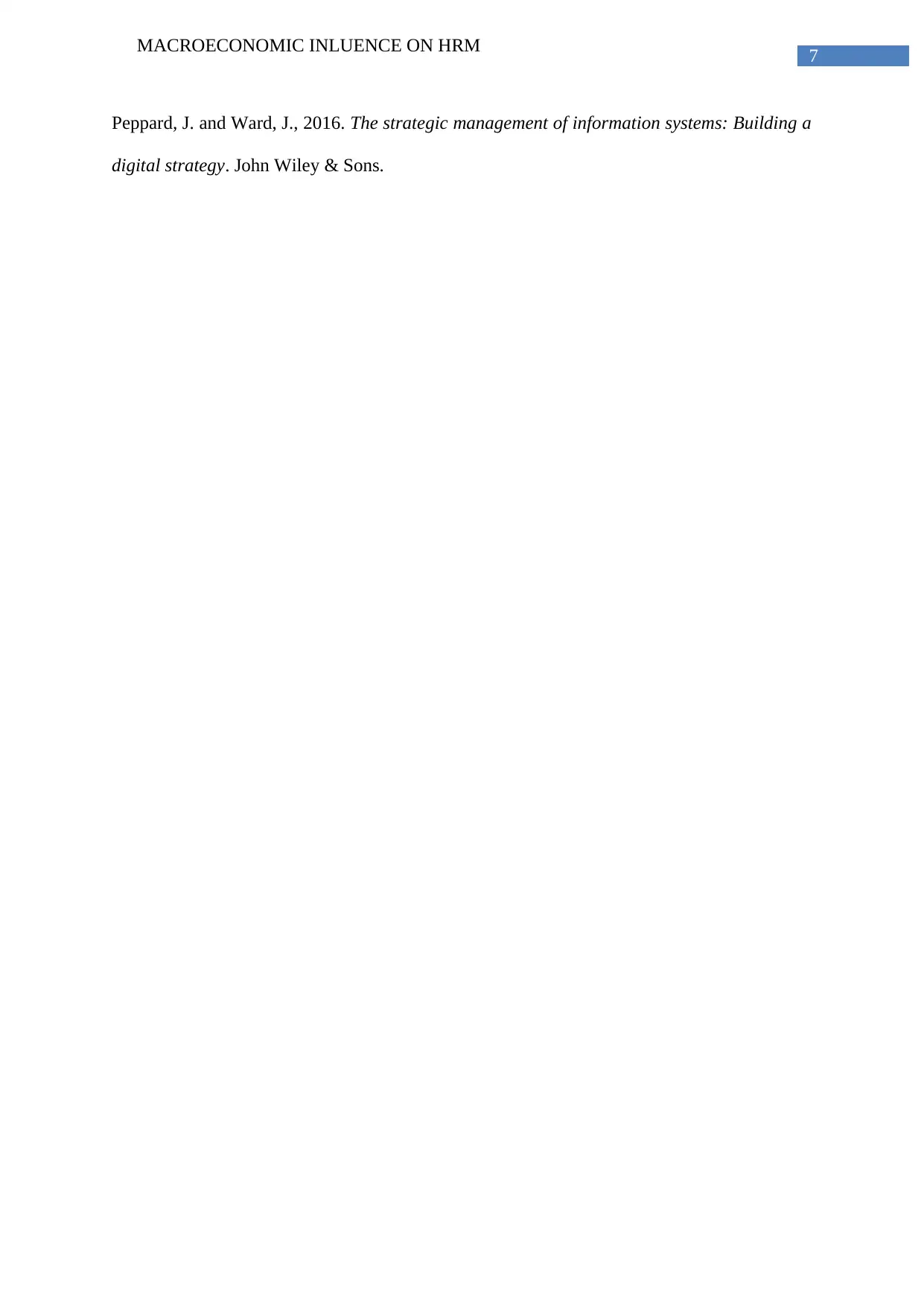
7
MACROECONOMIC INLUENCE ON HRM
Peppard, J. and Ward, J., 2016. The strategic management of information systems: Building a
digital strategy. John Wiley & Sons.
MACROECONOMIC INLUENCE ON HRM
Peppard, J. and Ward, J., 2016. The strategic management of information systems: Building a
digital strategy. John Wiley & Sons.
1 out of 8
Related Documents
Your All-in-One AI-Powered Toolkit for Academic Success.
+13062052269
info@desklib.com
Available 24*7 on WhatsApp / Email
![[object Object]](/_next/static/media/star-bottom.7253800d.svg)
Unlock your academic potential
Copyright © 2020–2025 A2Z Services. All Rights Reserved. Developed and managed by ZUCOL.





